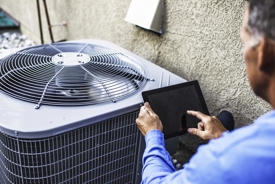14 SEER or 20 SEER: What’s the Difference?
If you’ve spent any time at all researching new air conditioning systems, you’ve seen the term “SEER rating.” So, you ask yourself, what does this mean, why is it so important and how does this help my energy bill?
Comparing Seer Ratings
SEER stands for Seasonal Energy Efficiency Ratio. The higher the SEER rating the more efficient the unit will run, thus leading to lower energy bills. If you compare a 10 SEER AC unit to a 20 SEER AC system, the 20 SEER system will provide twice the efficiency.
A Specific Example
If you are running an older 10 SEER, 5-ton model and it is operating at good-to-peak efficiency, your yearly cost of operation will be approximately $1,316.00 per year. Replacing this unit with a 20 SEER-rated system can bring that cost down by as much as 50% or $658.00 per year (SEER Savings, 2019). However, if you are weighing out the energy savings of a 14 SEER ($940 per year) compared to the same 20 SEER unit ($658 per year), you should expect the difference in savings to be lower over the next 15 years, because a 14 SEER can give you a substantial savings as well.
So, why would you consider the higher SEER rating? If comfort is one of the main concerns with your current system, then a higher SEER rating would be preferable because the higher SEER means more comfort. The higher efficiency systems (17 or higher) typically come with a two-stage compressor and a variable speed blower fan.
How Do These Changes Make a Difference in Efficiency and Comfort?
The standard 14 SEER system is either on or off. This means the fan and compressor are running at high speed the entire time it’s cooling your home. The two-stage compressor runs at two speeds, low and high. When the system comes on it automatically starts in low gear and runs very efficiently until it can’t keep up with the load. It then shifts into high gear until the temperature stabilizes, then down shifts to the more energy-efficient speed. The same goes for the blower fan as well. The lower speeds can meet your cooling needs about 80% of the time, which means it will run more often. The benefits of this operation are twofold: fewer hot/cold spots and less humidity.
The longer run-time allows for a better mixing of existing air and conditioned air, creating a more even temperature throughout the house. This longer run-time also allows for more water/humidity to be removed from the air, making your home more comfortable. In South Louisiana this is a big plus.
I know what you’re thinking: If the compressor runs longer, won’t that make my bill higher, not lower? Think of it this way: Your car gets better gas mileage on long distance trips than it does in stop-and-go traffic in town. The same goes for your compressor. Starting the compressor takes a greater amount of energy than to run at a constant speed. And, keep in mind, the lower speed of the two-stage compressor takes much less energy to run than the standard AC unit.

Need More AC Advice? Contact Bitter Heating & Air Conditioning, Inc.
At Bitter, our AC technicians have over 25 years of experience and are here to help answer these types of questions to make sure you have the right unit for your needs, guaranteed. Call us, we are ready to help: (225) 500-2035. You can also contact us online by filling out a contact form here.
Works Cited
SEER Savings, I. (2019). SEER Energy Savings. Retrieved from SEER Savings: https://www.seerenergysavings.com/


